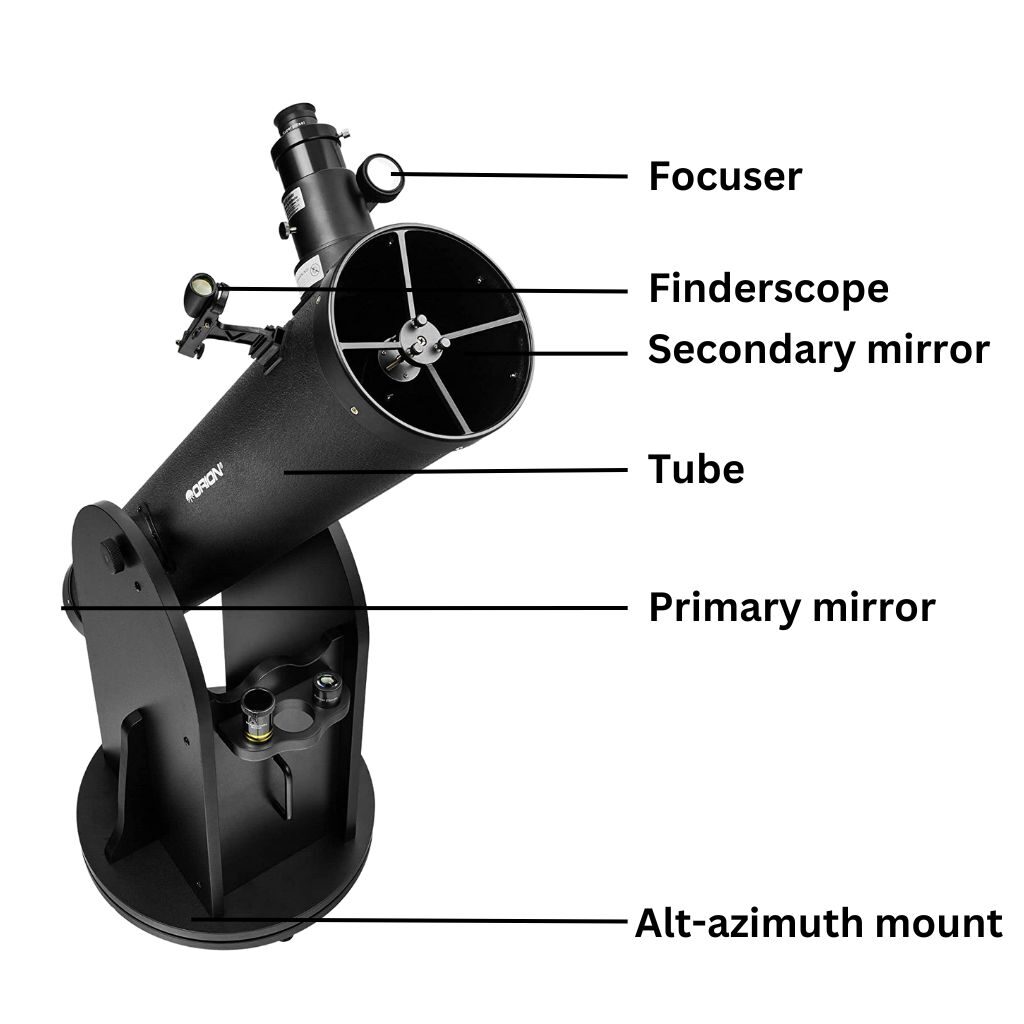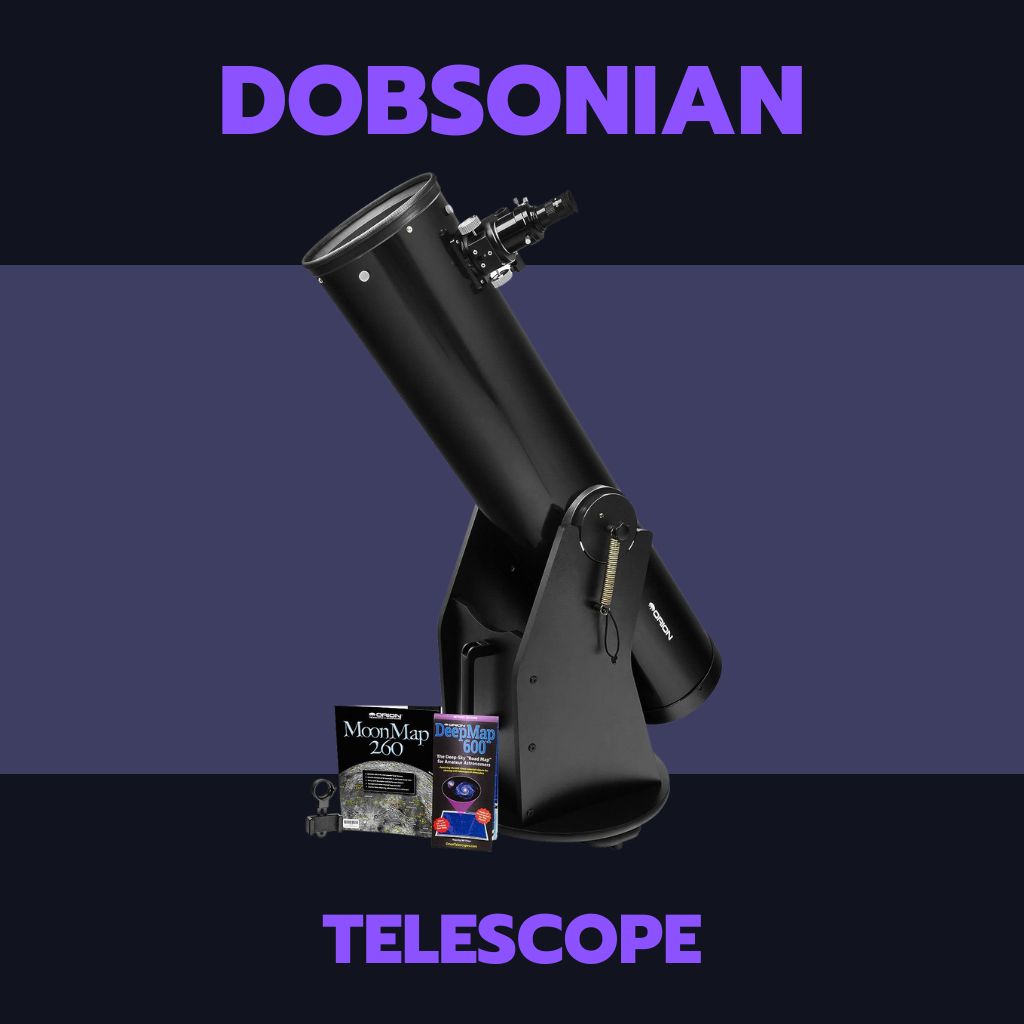This site contains affiliate links to products. I may receive a commission for purchases made through these links.
Born out of John Dobson’s innovative ideas in the 1960s, the Dobsonian telescope revolutionized the world of amateur astronomy by providing a simple yet effective design that made deep-sky viewing accessible to the masses.
But what exactly sets a Dobsonian apart from the sea of telescopes in the market? And how does its unique combination of mirrors produce the mesmerizing images of galaxies, nebulae, and star clusters that have endeared it to so many?
What’s particularly alluring about Dobsonian telescopes is their balance of power and simplicity. They are known for offering large aperture sizes at a relatively affordable price, making them ideal for those keen on observing fainter objects in the night sky.
Dobsonian telescopes utilize a primary parabolic mirror that gathers light, focusing it on a single point. This light then bounces off to a secondary flat mirror, redirecting it to the tube’s side for viewing.
In this post, we’ll look at Dobsonian telescopes, uncovering the secrets behind their mirror setup, exploring what makes them unique, and helping you understand whether a Dobsonian might be the right fit for your celestial pursuits.
Overview of Dobsonian telescopes
Dobsonian telescopes are a popular type of telescope designed for amateur astronomers. They are known for their simplicity, efficiency, and affordability.
Dobsonian telescopes are largely characterized by their simplicity and functionality. They operate on a straightforward alt-azimuth system, allowing smooth, seamless movement along vertical and horizontal axes.
The base is typically crafted with wood or other sturdy materials and is a firm, stable platform supporting the optical tube. It embodies a ‘form follows function’ philosophy prioritizing ease of use and stability.
Its low center of gravity ensures the telescope remains balanced, minimizing vibrations and facilitating a steady, unobstructed view of celestial objects.
Furthermore, the Dobsonian base is admired for its accessibility, inviting even novices to explore the cosmos without a steep learning curve.
Its intuitive design eliminates the need for complicated setups, allowing for quick and easy targeting of celestial bodies, fostering a user-friendly experience that is both satisfying and educational.
What are the main parts of a Dobsonian telescope?
The main parts of a Dobsonian telescope include the following:

Telescope tube
The tube is usually made of lightweight materials such as PVC or aluminum. It houses the primary mirror and optical elements, typically connected to the telescope mount.
The size of the optical tube will determine the size of the primary mirror. This means that a larger Dobsonian telescope will have a bigger mirror and, therefore, more light-gathering power.
Primary mirror
The primary mirror is the key to nighttime discovery, capturing light from faraway stars and galaxies. A brilliant reflection of glass or aluminum guides that glimmering illumination towards an eyepiece and magnifies it into a stunningly intimate view.
Most Dobsonian telescopes are equipped with a parabolic mirror to ensure optimal light collection – even more so than other designs. These mirrors have an aluminum or silver coating that amplifies each observation experience to maximize reflectivity.
Secondary mirror
A secondary mirror, placed at an angle to the primary, works like a miniature traffic director, optimizing light bouncing off the primary reflector towards the eyepiece.
It helps eliminate any optical distortion and results in breathtakingly sharp images.
Focuser
The focuser is an engineering marvel, working like an adjustable door to bring distant worlds into crystal-clear view. With just the turn of its small knob, users can move the telescope’s mirror closer or farther away from their eye for exquisite visual experiences in astronomy and stargazing.
Telescope focusers are adjustable for an optimal viewing experience to provide the sharpest and clearest imaging possible.
From Crayford models for precise focusing to helical variants that enable fine-tuning your setup, there’s a perfect option for stargazers of all levels.
Eyepiece
The eyepiece provides a closer look at even the faintest of celestial objects with its low magnification capabilities. You just point it towards the sky and stare deep into the universe.
Most Dobsonian telescopes have two or more eyepieces. You can change the eyepiece to adjust the magnification power, allowing you to observe different objects in more detail.
Alt-azimuth mount
The alt-azimuth mount allows you to effortlessly track objects in the sky with its two axes of rotation. Its simple yet effective design makes it easy for stargazers and astronomers to move their telescopes up and down or left and right.
The Dobsonian mount provides a rock-solid platform to support your telescope. Crafted from durable materials, it prevents unwanted shaking or vibrating during use and offers finely tuned slow-motion control knobs for precise tracking with smooth maneuverability.
You can improve stability and reduce vibrations with the Solomark Anti-Vibration Suppression Pads Telescope Mounts. These pads are made of soft rubber and provide a cushion between your telescope and the mount.
Laser collimator
A laser collimator is an essential tool for ensuring the optics of your Dobsonian telescope align correctly. It uses a laser emitter and receiver to measure mirror alignment, providing clear, sharp views when stargazing or observing distant galaxies in amazing detail.
Although this invaluable device isn’t always included in the package, it’s one item every astronomy enthusiast should have.
Rocker box/ground board
The rocker box or ground board is the Dobsonian telescope’s base, providing stability and support for the telescope tube. It usually consists of two flat boards connected by hinges, allowing the telescope to move side-to-side to focus on different objects in the sky.
Rocker boxes come in various sizes and materials, usually made of wood or metal. They can also be equipped with wheels to make it easier to transport Dobsonian telescopes from one location to another.
How do Dobsonian telescopes work?
Dobsonian telescopes have an operational mechanism primarily centered on using a primary parabolic mirror to concentrate light. The mirror captures and funnels light to a focus point.
This process is facilitated by the scope’s substantial aperture, which guarantees detailed and vibrant imagery of celestial entities.
The image formed is then deflected by a secondary flat mirror positioned at the side of the tube.
Here, you can observe it through an eyepiece, showcasing the telescope’s seamless integration of simplicity and functionality in image production.
The setup phase of a Dobsonian telescope is relatively uncomplicated. It fosters a user-friendly experience even for beginners.
Primarily, it involves positioning the telescope tube on a pair of altitude bearings or trunnions. These have a smooth plastic surface to facilitate upward and downward movements easily.
The design not only makes the setup process quicker but also cheaper. This showcases the Dobsonian telescope as a cost-effective yet efficient choice for astronomical observations.
The intuitive design of the Dobsonian extends to its movement capabilities. It employs additional plastic components on Teflon pads to enable side-to-side, or azimuth, motion.
This creates just the right amount of friction to firmly hold the telescope. It also allows easy repositioning when necessary, making tracking celestial objects a breeze.
Despite their manual operation, Dobsonian telescopes bring a considerable advantage in terms of convenience and portability.
This manual method makes the telescope lighter and easier to set up and significantly more affordable than mounts of other styles.
What is a Dobsonian telescope used for?
A Dobsonian telescope is renowned for its ability to provide exceptional views of deep-sky objects in the night sky.
With their substantial apertures and uncomplicated design, Dobsonian telescopes excel in capturing faint light from distant celestial wonders such as galaxies, nebulae, and star clusters.
These telescopes offer impressive, detailed views of deep-sky objects, revealing structures and subtle features that may be challenging to discern with smaller telescopes.
Their wide-field views are particularly well-suited for exploring large star fields, open clusters, and the Milky Way.
Features of a Dobsonian telescope
Dobsonian telescopes are revered in the astronomical community for their user-centric features. These include:
Simple alt-azimuth mount
The Dobsonian features an alt-azimuth mount, which moves vertically (altitude) and horizontally (azimuth). This intuitive movement system allows for straightforward pointing and tracking of celestial objects without the complexities of equatorial mounts.
Large aperture sizes
One of the primary advantages of Dobsonian telescopes is their large apertures. A bigger aperture collects more light, meaning brighter and more detailed views of celestial objects, especially faint and distant objects.
Stable and robust base
The design of the Dobsonian emphasizes stability. Its broad, sturdy base ensures the telescope remains balanced and reduces vibrations, resulting in clearer, steadier observations.
Manual operation for hands-on navigation
Instead of automated tracking systems, Dobsonians are typically operated manually. This hands-on approach allows astronomers to intimately familiarize themselves with the night sky. It offers a more personal and engaging stargazing experience.
Efficient light-gathering capabilities
The significant aperture of a Dobsonian, paired with its reflective mirrors, ensures that it captures and focuses a maximum amount of light. This feature is crucial for revealing the intricate details of deep-sky objects.
Easy setup and use
Dobsonians are renowned for their simplicity. With fewer complicated parts and an intuitive design, setting up and using the telescope becomes straightforward, reducing the learning curve for beginners.
Origin of Dobsonian telescopes
Dobsonian telescopes trace their roots back to John Dobson, an American amateur astronomer from whom the telescope derives its name.
In the 1960s, Dobson sought to make large-aperture telescopes more accessible and affordable to the public. He nicknamed this project “the sidewalk telescope.”
Dobson developed a unique design that combined a simple yet sturdy wooden mount.
He used optical components sourced from surplus or discarded materials, like ship portholes or even glass shower doors, to create his innovative telescope.
The true revolution behind the Dobsonian design wasn’t necessarily in the optics but rather in the mount.
Dobson’s alt-azimuth mounting system, marked by its uncomplicated mechanism and stability, allows for easy maneuverability of larger telescopes.
As a co-founder of the “San Francisco Sidewalk Astronomers,” Dobson popularized this design by showcasing its potential on city streets.
This ensured the telescope’s enduring legacy in the world of amateur astronomy.
Dobsonian telescope design
The Dobsonian telescope design is a culmination of simplicity and efficiency, evolving from its classic roots to modern adaptations over time. Here are the main designs:
Classic Dobsonian telescope design
The classic Dobsonian is essentially a Newtonian reflecting telescope mounted on an alt-azimuth base. Its optical tube assembly, which holds the primary and secondary mirrors, is straightforward and mimics the basic design of traditional Newtonian telescopes.
This design primarily focuses on visual astronomy, foregoing the complexities often found in refracting telescopes. Such a telescope is excellent for beginners.
With a solid yet simple wooden base, the classic design emphasizes ease of use and portability, making it a favorite for those who prioritize direct, hands-on stargazing.
Modern Dobsonian telescope design
As technology and materials have advanced, so too has the Dobsonian design. Modern Dobsonians still maintain the core principles of the Newtonian telescope but integrate newer materials and features for added convenience and performance.
Modern designs often utilize durable and lightweight materials instead of the wooden bases in classic models.
Some modern Dobsonians even incorporate computerized tracking systems.
They bridge the gap between the pure manual experience of traditional Dobsonians and the automated convenience of contemporary telescopes.
Despite these advancements, the heart of the Dobsonian—its Newtonian optical tube assembly—remains central. It ensures that the telescope remains true to its origins, whether classic or modern.
Is a Dobsonian telescope good for beginners?
A Dobsonian telescope is often touted as one of the most recommended choices for beginners. The primary reason is its inherent simplicity.
The uncomplicated alt-azimuth mount makes it straightforward to set up and use. Beginners can easily navigate the night sky without getting overwhelmed by intricate settings or adjustments.
Additionally, its design offers a generous aperture size. Even novice stargazers can enjoy clear and detailed views of celestial objects.
Its manual operation encourages hands-on learning, helping beginners familiarize themselves with the sky’s layout and the telescope’s operation.
How much does a Dobsonian telescope cost?
The cost of a Dobsonian telescope can vary widely depending on its specifications, especially aperture size. For those on a budget, there are beginner-friendly Dobsonian telescopes with smaller apertures, around 6 inches, you can find for under $500.
As the aperture size increases, so does the price. Telescopes with an aperture in the 8 to 10-inch range often fall within $500 to $1,000.
If you’re looking at more advanced models with larger apertures, around 12 inches and above, the price can hover around $1,000 to $2,000 or more. These larger telescopes capture more light, offering brighter and clearer views of distant celestial objects.
It’s worth noting, however, that as the aperture and features increase, the telescope’s size and weight typically do as well, which might be a consideration for portability.
For enthusiasts seeking top-of-the-line Dobsonians with the largest apertures and the most advanced features, prices can soar to $2,000 and beyond.
At this range, you’re investing in exceptional viewing capabilities and often additional conveniences like enhanced optics, precision mounts, and sophisticated computerized functions.
You may also like: 10 Reasons Why Dobsonian Telescopes Are Cheaper
Best Dobsonian telescopes
Stepping into the world of stargazing becomes an exhilarating adventure with the right Dobsonian telescope in your hands.
Here are some of the most popular ones:
Orion SkyQuest XT6 Classic Dobsonian Telescope
The Orion 8944 SkyQuest XT6 Classic Dobsonian Telescope is a standout choice for beginners embarking on their first Dobsonian telescope experience.
It boasts a generous 6″ aperture, offering unparalleled visual observing opportunities. Its f/8 parabolic mirror, paired with an efficient secondary mirror, ensures breathtaking clarity.
Designed for ease, the SkyQuest XT6 sidesteps the intricacies of polar alignment.
The Dobsonian base ensures stability, making celestial tracking smooth and straightforward. This marks it as an invaluable asset for anyone’s stargazing journey.
See also: Orion SkyQuest XT8 Review (#1 Beginner Telescope)
Orion Skyline 8″ Dobsonian Reflector Telescope
For amateur astronomers seeking optimal visual observing, the Orion Skyline 8″ Dobsonian reflector telescope stands out as a prime choice.
As a Newtonian reflecting telescope, it boasts an 8″ primary mirror with 94%-96% reflectivity, ensuring bright and clear views of the brightest deep sky objects.
The Dobsonian design, coupled with an easily adjustable secondary mirror, guarantees user-friendly alignment and effortless tracking.
The Skyline merges the simplicity of a Dobsonian mount with features like a cooling fan and dual-speed Crayford focuser, making it an excellent tool for both novices and seasoned stargazers.
You may also like: Orion Telescopes Dobsonian (All Models Compared!)
Sky-Watcher Classic 250 Dobsonian 10″ Telescope
The Sky-Watcher Classic 250 Dobsonian Telescope offers a stellar blend of visual astronomy essentials and user-friendly features. Its 10-inch aperture ensures bright views of deep space wonders and distant objects with ease.
Its clarity is paramount, thanks to the 94% reflective, fully multi-coated borosilicate mirrors. The proprietary tension control handles and Teflon bearings allow seamless tracking of celestial bodies.
As a classical Dobsonian, its design is both sturdy and lightweight. With accessories like the Crayford-style focuser and wide-angle eyepieces, it’s a complete package for both newcomers and seasoned stargazers.
Celestron Starsense Explorer 12″ Dobsonian Telescope
The Celestron Starsense Explorer 12″ Dobsonian Telescope features integrated StarSense technology and a large 12-inch parabolic primary mirror equipped with XLT coatings.
This powerhouse facilitates swift spotting and detailed viewing of faint, deep-sky objects. It is complemented by the SkySafari app, which automatically curates a list of currently visible celestial wonders.
It promises both beginner and seasoned astronomers an enriched stargazing experience. You can use it to view planets and distant galaxies in urban or darker environments.
More options here: 10 Best Dobsonian Telescopes (Ranked!)
How do I use Dobsonian Telescopes?
Using a Dobsonian telescope is a straightforward process for beginners.
Here is how to use it:
- Start by setting up the telescope on a stable, level surface away from bright lights.
- Balance the telescope so it moves smoothly in both altitude and azimuth.
- Locate your target using the finderscope and adjust the telescope’s position as needed.
- Focus on the object with the telescope’s knobs, and once you’ve achieved a clear view, take your time to observe and enjoy.
- Dobsonian telescopes are manually operated, so you’ll need to track objects as they move across the sky.
With practice, you’ll become skilled at exploring celestial objects with your Dobsonian telescope.
To learn more, read: How to Use a Dobsonian Telescope (Beginners Guide)
What type of mount is used in a Dobsonian telescope?
Dobsonian telescopes utilize a distinctive alt-azimuth mount. This mount operates on a straightforward vertical (altitude) and horizontal (azimuth) axis system.
You have to move the telescope up and down or side to side to target and track celestial objects.
What are the recommended Accessories for Dobsonian telescopes?
Some accessories are highly recommended to enhance the capabilities and convenience of Dobsonian telescopes. A set of varied eyepieces can expand the range of magnifications available.
A Barlow lens, such as the Celestron 1.25-inch Universal 2x Barlow Lens, can be a valuable addition, as it effectively doubles or triples the magnification of any eyepiece, offering versatility without the need for numerous eyepieces.
Another accessory to consider is a quality red dot finder or a finderscope, such as the Celestron StarPointer Pro Finderscope. These tools aid in pinpointing specific celestial objects, streamlining the process of aligning the main telescope to desired targets.
You can integrate a computerized tracking system if you desire a touch of modernity with their Dobsonian. This system automates the tracking of celestial bodies, ensuring they stay centered in view even as they move across the sky.
Advantages of a Dobsonian telescope
Dobsonian telescopes, when compared to other models like the refracting telescope, present a distinct set of advantages tailored for the avid sky watcher.
Here are some of them:
Large aperture at an affordable price
Dobsonians offer large apertures at a fraction of the cost. This allows for impressive light-gathering capabilities, making deep-space objects like nebulae and galaxies more discernible during visual observation.
Simplicity and ease of use
Dobsonian mounts have a straightforward design. Unlike the equatorial mount, the Dobsonian mount operates on a basic alt-azimuth system. This makes targeting and tracking celestial objects intuitive and hassle-free for users of all levels.
Stability
Dobsonian mounts are inherently stable and robust. Their low center of gravity ensures minimal vibrations, offering clear and steady views of the night sky.
Read also: 5 Advantages and Disadvantages of Dobsonian Telescopes
Limitations of a Dobsonian Telescope
While Dobsonian telescopes have earned acclaim in the astronomy community, they are not without their limitations.
Here are some of the limitations of this telescope:
Size and portability issues
Due to their design, especially models with larger apertures, Dobsonian telescopes can be quite bulky. This might make transportation and storage a challenge, especially when compared to some compact refracting telescopes.
Limited astrophotography capabilities
While perfect for visual observation, Dobsonian mounts are not ideal for long-exposure astrophotography.
The absence of an equatorial tracking system means they can’t easily follow the precise arc of the sky, which is crucial for capturing clear images of celestial objects over extended periods.
What is the effect of the Dobsonian on amateur astronomy?
The Dobsonian revolutionized amateur astronomy by making large-aperture telescopes accessible and affordable.
Its simple design and ease of use democratized deep-sky viewing, allowing enthusiasts to observe celestial wonders previously visible only through professional-grade equipment.
The Dobsonian sparked a renewed passion and broader participation in backyard astronomy by bridging the gap between novice stargazers and the universe.
Can I build my own Dobsonian telescope?
Many amateur astronomers have crafted their own telescopes using readily available materials, such as plywood for the mount and surplus or custom-made mirrors for the optics.
It is a feasible endeavor, especially given its straightforward design.
With the right tools, guidance, and dedication, constructing a Dobsonian telescope can be both a rewarding project and a gateway to the wonders of the cosmos.
To learn how to build yours, read: How to Build a Dobsonian Telescope? Step-by-Step Guide for Beginners
How do I care for my Dobsonian telescope?
Caring for your Dobsonian telescope involves ensuring it’s stored in a dry, dust-free environment when not in use.
Since the mirrors are the most delicate components, you should clean them infrequently and only when necessary.
Use appropriate methods like air blowers or soft brushes to remove particles.
Avoid touching the optical surfaces, and when transporting, secure all components to prevent any damage.
Regularly inspect the mount for smooth operation, making necessary adjustments or lubrication to maintain its seamless movement.
Is a Dobsonian telescope worth buying?
A Dobsonian telescope offers a perfect blend of affordability, large aperture, and ease of use. It is ideal for both beginners and seasoned astronomers.
Its simple design ensures straightforward operation, while its substantial light-gathering capability provides stunning views of deep-sky objects.
A Dobsonian is a worthy investment for anyone keen on immersive stargazing without delving deep into their pockets.
What is the main difference between a Dobsonian and a Newtonian telescope?
The primary difference between a Dobsonian and a Newtonian telescope lies in the mount, not the optics.
Both utilize the same Newtonian reflecting optical design, with a parabolic primary mirror and a flat secondary mirror.
However, a Dobsonian telescope is mounted on a simple, easy-to-use alt-azimuth base.
In contrast, a Newtonian is typically mounted on an equatorial mount, which can be more complex but allows for tracking the movement of celestial objects across the night sky.
To learn more, read: Dobsonian vs Newtonian Telescopes: 5 Differences Explained!
Takeaway: Embrace the Dobsonian telescope experience by learning how it works
The Dobsonian telescope, an adaptation of the Newtonian reflector, has revolutionized astronomy for beginners with its user-friendly design and effective optics.
Its unique alt-azimuth mount ensures simplicity in use and handling. The design differences between the classic and modern versions cater to both nostalgic stargazers and tech-savvy astronomers.
With a focus on visual observation, Dobsonians offer a cost-effective gateway to deep space explorations and detailed planetary views.
You may also like:










